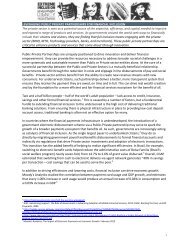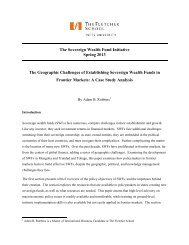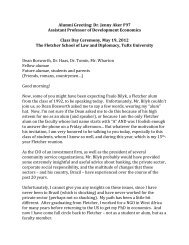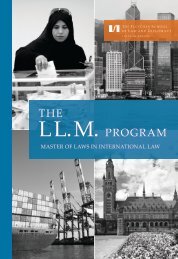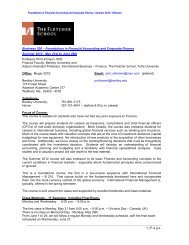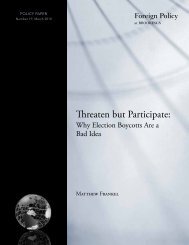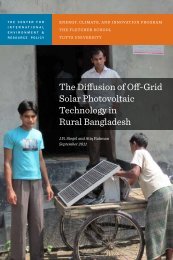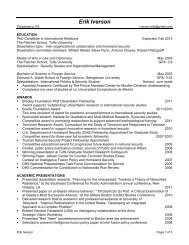creating a mutual Gains climate regime through universal clean ...
creating a mutual Gains climate regime through universal clean ...
creating a mutual Gains climate regime through universal clean ...
Create successful ePaper yourself
Turn your PDF publications into a flip-book with our unique Google optimized e-Paper software.
The Sustainable Development Diplomacy and GovernanceProgram (SDDG)Center for International Environment and Resource Policy (CIERP)The Fletcher School, Tufts UniversityCabot Intercultural Center, Suite 509160 Packard AvenueMedford, MA 02155www.fletcher.tufts.edu/cierpThe Fletcher School at Tufts University was establishedin 1933 as the first graduate school of international affairs inthe United States. The primary aim of The Fletcher Schoolis to offer a broad program of professional education ininternational relations to a select group of graduate studentscommitted to maintaining the stability and prosperity of acomplex, challenging, and increasingly global society.The Center for International Environment and ResourcePolicy (CIERP) was established in 1992 to support thegrowing demand for international environmental leaders.The Center provides an interdisciplinary approach to educategraduate students at The Fletcher School. The programintegrates emerging science, engineering, and businessconcepts with more traditional subjects such as economics,international law and policy, negotiation, diplomacy, resourcemanagement, and governance systems.The Sustainable Development Diplomacy and GovernanceProgram (SDDG) focuses its research on the processes of<strong>creating</strong> policies and on how effectively alternative governancesystems and policies can create sustainable developmentsolutions. Negotiations over global and transboundaryissues for the most part are locked into traditional modelsof diplomacy. Pioneering a new diplomacy of environmentand resource policy will require new approaches basedupon <strong>mutual</strong> gains principles of negotiation, stakeholderparticipation, the engagement of multiple institutions andcoordination of multiple treaties and actions.This report was printed using 100% wind-energy ona paper made of 100% post-consumer waste fiber.
Creating a Mutual <strong>Gains</strong> Climate Regime Through Universal Clean Energy ServicesTable of ContentspageSECTION 1: INTRODUCTION 2SECTION 2: FAILURE TO RESPOND TO THEUNDERLYING CAUSES OF CLIMATE CHANGE 32.1 Misdiagnosis of the Problem 42.2 Negativism: Pursuing the Minimal Share of the Burden 5SECTION 3: ACHIEVING MUTUAL GAINS INMULTIPARTY NEGOTIATION 7SECTION 4: IMPLEMENTING A MUTUAL GAINS APPROACH 104.1 Reframing the Problem 104.2 Towards a Different Normative Push for Action 14SECTION 5: CONCLUSIONS 17BIBLIOGRAPHY 19AcronymnsCDMCO 2GHGIPCCkWODSREDD+Clean Development MechanismCarbon DioxideGreenhouse GasIntergovernmental Panel on Climate ChangeKilowattOzone-Depleting SubstancesReducing Emissions from Deforestation and Forest Degradation PlusUNFCCC United Nations Framework Convention on Climate ChangeWTOWorld Trade OrganizationCenter for International Environment and Resource Policy, The Fletcher School, Tufts University 1
Creating a Mutual <strong>Gains</strong> Climate Regime Through Universal Clean Energy ServicesSection 1: IntroductionClimate change is one of the greatest global policy challenges of the 21st century.Scientists have reached consensus that warming of the <strong>climate</strong> system is attributableto human actions (IPCC, 2007). The impacts of <strong>climate</strong> change on ecosystemhealth and human well-being and, by extension, on the political, security, economic,developmental, and ethical aspects of international cooperation are well documented(IPCC, 2007), and adverse impacts of a substantially warmer <strong>climate</strong> are expectedto fall disproportionately on developing countries. Failure to reverse the rapid rise inglobal temperature, increases the ongoing damage from <strong>climate</strong> change, requires morefrequent intervention to alleviate acute impacts, raises the costs of adaptation, andincreases the likelihood of major dangerous irreversible changes in the global <strong>climate</strong>system. In light of this, a key question is why have the <strong>climate</strong> negotiations remaineddeadlocked and failed to produce a viable and adequate <strong>climate</strong> treaty? This paper putsforward the argument that, unless the current approach to the problem changes, theprospect of producing an effective response seems bleak.Drawing on <strong>climate</strong> policy scholarship and negotiation analysis, this article firstanalyses why the current approach does not produce an effective <strong>climate</strong> agreement.Arguing that the underlying national interests of most countries are surprisinglysimilar and focus on economic development rather than emissions reductions, it thenasks how to build on each country’s interests to create <strong>mutual</strong> gains outcomes forall parties. As <strong>climate</strong> change is fundamentally reframed as a development problem,a development-based approach to <strong>climate</strong> negotiations is proposed, which puts thechoice of <strong>clean</strong> development pathways and <strong>universal</strong> access to <strong>clean</strong> energy services atthe centre of the discussion. This approach enables parties to address <strong>climate</strong> changecollaboratively, promote the discourse of opportunity, and set foundations for problemsolving for the near- and long-term.2 Center for International Environment and Resource Policy, The Fletcher School, Tufts University
Creating a Mutual <strong>Gains</strong> Climate Regime Through Universal Clean Energy ServicesSection 2: Failure to Respond to theUnderlying Causes of Climate ChangeThe current international strategy to address <strong>climate</strong> change is based on severalassumptions: that CO 2can be internationally regulated as a pollutant and as a commodity;that setting emission targets can be an incentive for countries to prevent overproductionof CO 2; and, that developed countries have the primary responsibility for emissions andshould accept legally binding commitments to cut emissions before developing countriesneed to do so. This ‘pollution model’ strategy was formalized <strong>through</strong> the Kyoto Protocol(UNFCCC, 1997), the multinational agreement on GHG mitigation.In December 2009, the parties to the United Nations Framework Convention onClimate Change (UNFCCC) and the parties to the Kyoto Protocol met in Copenhagento chart the future of the international <strong>climate</strong> treaty and commit to deep cuts inemissions. Instead, the Conference produced the Copenhagen Accords (UNFCCC,2010), which comprised a statement of intentions without any legally bindingrequirements. The Conference exposed the difficulties of building consensus on cuttingemissions and illustrated the weaknesses of using the pollution model to respond to<strong>climate</strong> change. It is not in the short-term political interest of any single government toaccept a portion of the emissions reduction burden to address what is a common set of<strong>universal</strong>, long-term practices that have led to global warming and <strong>climate</strong> change.The two most pronounced weaknesses of the pollution model, that act as majorobstacles to progress in <strong>climate</strong> negotiations, are (i) that it misdiagnoses <strong>climate</strong>change as pollution rather than as a development problem and (ii) in doing so, itpromotes the negative message of ‘burden sharing’ rather than ‘opportunity sharing.’The inability of the Cancun meeting in 2010 to do more than salvage the UN processfurther demonstrated that reaching <strong>mutual</strong> gains <strong>through</strong> international cooperationseems increasingly unlikely and that negotiators are losing trust in the relevance of thecurrent approach.Center for International Environment and Resource Policy, The Fletcher School, Tufts University 3
Creating a Mutual <strong>Gains</strong> Climate Regime Through Universal Clean Energy Services2.1 Misdiagnosis of the ProblemWhen pressed to increase their commitment to reduce emissions, the responses ofgovernment officials are remarkably similar, and illustrate a near-<strong>universal</strong> agreementof why the current approach fails.• ‘We will not cut our development potential’. 1• (Our) ‘lifestyle is not up for negotiation’. 2• (It) ‘would cost us jobs and damage our industry’. 3• (It) ‘would have a negative impact on the living standards (. . .) and for thecompetitiveness and for our businesses’. 4• ‘A more ambitious target would constrict (our) development space’. 5Each of these statements is from a different world leader (President Dmitri Medvedevof Russia, President George W. Bush of the US, Prime Minister John Howard ofAustralia, Environment Minister Maciej Nowak of Poland and Environment MinisterJairam Ramesh of India, respectively), but they reflect a common concern: morestringent emission targets have been interpreted to mean a negative impact on thequality of life and a restriction on countries’ development potentials. The commonbelief is that increased GHG emissions mean more economic development. Becauseeconomic development is so heavily driven by energy, and nearly 85% of primary energyis from fossil fuels that produce CO 2(Smil, 2006; IPCC, 2012), most governments(mistakenly) equate emissions with development. When they make this assumption,acting on <strong>climate</strong> change is seen as an additional drain on economic development,which is assuredly not in the national interest of any country.However, emissions are only a symptom of the underlying problem: unsustainabledevelopment (see also Prins et al., 2010). The key question is not how to limit emissionsor place constraints on the output of unsustainable development, but how to placeconstraints on the inputs in the development process, so that countries at differentlevels of development can make the transition to more <strong>climate</strong>-friendly developmentpathways (Heller and Shukla, 2003; Birdsall and Subramanian, 2009). Focusing onthe symptoms of <strong>climate</strong> change has sidelined the imperative of rethinking the verychoice of fossil fuels as inputs into the development process and diverts attention awayfrom development strategies with ancillary <strong>climate</strong> benefits (IPCC, 2012). The KyotoProtocol attempted to assist developing countries in <strong>climate</strong> change mitigation: theClean Development mechanism (CDM) allows the crediting of emission reductions1Russian President Dmitri Medvedev, quoted in Shuster (2009).2George Bush refered to the American lifestyle when stating the US position at the 1992 EarthSummit.3In 2002, Australian Prime Minister Howard explained why Australia would not ratify the Kyoto Protocol(Howard, 2002).4Polish Environment Minister Maciej Nowicki quoted in AFP (2008).5India’s environment and forests minister Jairam Ramesh quoted in Venu and Narendranath (2010).4 Center for International Environment and Resource Policy, The Fletcher School, Tufts University
Creating a Mutual <strong>Gains</strong> Climate Regime Through Universal Clean Energy Servicesfrom GHG abatement projects in developing countries and has been used both toimplement many specific projects and to enable developed countries to cut theiremissions modestly (Metz, 2010). However, although the CDM process has evolved asan offsetting mechanism, it has been cumbersome and largely ineffective in providingthe incentives for developing countries to pursue <strong>climate</strong>-protecting developmentpaths consistently and at the necessary scale (Sterk et al., 2007; Schneider, 2009;Bakker et al., 2011).As a result of the misdiagnosis of the problem, the focus on emissions has not producedthe desired gains for either developing or developed countries. An asymmetryexists for developing countries. Although developing countries are expected to face75–80% of the potential damage from <strong>climate</strong> change (World Bank, 2010), most havehistorically played a minor role in causing the problem. Their <strong>climate</strong> vulnerabilitiesand adaptation needs have been marginalized in international <strong>climate</strong> cooperation, andpotential synergies between mitigation and adaptation remain largely underexplored(Beg et al., 2002; Davidson et al., 2003; Najam et al., 2003; Agarwala, 2005; Bradleyet al., 2005; Pielke, 2005). Developed countries have also found emissions-centeredpolicies problematic. Because emissions vary with levels of economic development,resource endowments and the pace of technological change, they have been difficultto manage, and the compliance of some countries like Japan, Australia, and especiallyCanada has been particularly weak (see also Victor, 2001; Prins and Rayner, 2007).International emissions trading has been established in the European Union, Norway,and New Zealand, but the degree of the impact of this mechanism has been limitedgiven that the US, Canada, Australia, and Japan have remained outside the trading<strong>regime</strong>. Moreover, none of the large emitting developing countries have participated,even though developing countries now account for over half of global GHG emissions.The Kyoto Protocol prescribes property rights where the permitted global quota ofemissions is divided among parties and is ‘legally binding,’ but like many (but notall) treaties, it cannot enforce compliance. Without <strong>universal</strong> acceptance by the keydeveloped-country emitters (especially the US) of stringent, binding targets first, thepollution model has not delivered the results developing countries expected in the firstcommitment period, which has discouraged them from pursuing the same path due toboth political and functional reasons. The framing of the problem therefore weakensthe prospect for evolution of cooperation in the long term, and, as illustrated next,contributes to the negativism of the debate.2.2 Negativism: Pursuing the Minimal Share of the BurdenBecause the dominant institutional response to <strong>climate</strong> change is conceptualized as astrategy for sacrifice, rather than investment and opportunity, negotiators have beenspeaking mostly of ‘burden sharing’ (see Nordhaus and Shellenberger, 2007; Baer etal., 2008; Parker, 2008; ENB, 2009; World Bank, 2010, p. 236). Countries argue thatthey should sacrifice less than other countries and develop defensive positions withCenter for International Environment and Resource Policy, The Fletcher School, Tufts University 5
Creating a Mutual <strong>Gains</strong> Climate Regime Through Universal Clean Energy Servicesrespect to binding emission targets. Hence, there is major discussion about equalper-capita rights to use the atmosphere for disposing of heat-trapping GHGs andabout prioritizing current versus cumulative emissions. Countries approach <strong>climate</strong>negotiations as a conflict rather than a collaborative effort to solve a major problem, andthey hold on to their fixed positions in order to minimize their losses. Such adversarialpositional bargaining does not move the negotiations forward. A major clash ofpositions is apparent between the US (the biggest cumulative emitter of CO 2) and China(the biggest current emitter). Each country blames the other for its contribution to theproblem and the lack of action (see Reuters, 2010). The tension between the US andChina reflects a deeper political dynamic between developed and developing countries.Developed countries want developing countries also to act on their emissions, andsome developing countries have pushed developed countries to acknowledge theirresponsibility for damage suffered from <strong>climate</strong> change (Tol and Verheyen, 2005).Adversarial positions strengthen as the <strong>climate</strong> deteriorates over time (IPCC, 2007;Risbey, 2008) and as pressure builds on policy makers to develop a post-KyotoProtocol reduction agreement for after 2012. As the deadlock continues, there isincreasing doubt about the value of large-scale international <strong>climate</strong> negotiations andthe importance of using global institutions to respond to <strong>climate</strong> change. Althoughcriticism of the international cap-and-trade system in place is extensive (e.g.Guruswamy, 2007; Posner and Sunstein, 2009), a few scholars raise an even largerissue: the very utility of international law in addressing the problem of <strong>climate</strong> change.Some object to regulatory strategies focused on top-down approaches. Although theKyoto Protocol allows states to choose how they implement their commitments, itdoes not give them similar flexibility in defining the form, nature, and content of theircommitments (Bodansky, 2011). This suggests states may miss opportunities forincremental gains and innovation at other levels of governance (Osofsky, 2009). Othersargue that the limits of international law in addressing <strong>climate</strong> change are presentbecause the international system privileges economic interests above traditional legalrights and societal interests (Badrinarayana, 2010).All of these criticisms demonstrate that the pollution model as a <strong>climate</strong> protectionstrategy undermines each party’s perceived national interest and their ability todesign and sustain international <strong>climate</strong> cooperation over time. This article askswhether an alternative model, sustainable development, would be more effective. 6 Ituses negotiation theory to consider how to transform the currently stalled negotiationprocess into a process that advances national interests and results in <strong>mutual</strong> gains.6See IPCC (2007) for a discussion of the relationship between <strong>climate</strong> change and sustainabledevelopment.6 Center for International Environment and Resource Policy, The Fletcher School, Tufts University
Creating a Mutual <strong>Gains</strong> Climate Regime Through Universal Clean Energy ServicesSection 3: Achieving Mutual <strong>Gains</strong> inMultiparty NegotiationsThe field of negotiation analysis clearly demonstrates that it is possible to pursuea ‘<strong>mutual</strong> gains’ agreement for <strong>climate</strong> (in which all parties will exceed their nextbest option, which is no agreement) when parties engage in collaborative problemsolving. The foundations of this approach have been established in Roger Fisher andWilliam Ury’s book Getting to Yes, in which they introduced fundamental principles ofnegotiation that can help parties reach <strong>mutual</strong> gains outcomes: (i) separate the peoplefrom the problem; (ii) focus on interests, not positions; (iii) invent options for <strong>mutual</strong>gain; and (iv) insist on objective criteria (Fisher and Ury, 1981). The central idea behindthese principles is that they can help parties avoid hard bargaining and adversarialnegotiation style without giving in. These principles can result in ‘nearly self-enforcing’<strong>mutual</strong> gains agreements, because to comply is in the interest of most parties. Focusingon interests rather than on negotiating positions can help parties achieve an agreementby consensus rather than compromising to the lowest common denominator. Findingcommon interests and <strong>mutual</strong> gains outcomes can enlarge the total value of theoutcome and then many parties can claim a bigger share of value in the outcome inabsolute terms (Susskind et al., 1999).The Kyoto Protocol-based <strong>climate</strong> negotiations have violated most of the principles of<strong>mutual</strong> gains negotiations:• Rather than separating the people from the problem, the key emitters have beenengaged in a blame game about who is more responsible and who should act firstrather than fully committing to joint problem solving.• Negotiations have focused on positions where countries would make claims abouttheir emission rights rather than ensuring that the interests behind these positionsare aligned and reflect their interest in developing in a low-carbon manner.• It was anticipated that the Kyoto ‘flexibility mechanisms’ would allow alternatives tothe contentious requirement to reduce directly one’s own emissions and lower one’spotential for development and, at the same time produce gains for countries and theatmosphere. However, despite the establishment of international emissions trading,CDM and Activities Implemented Jointly, and the achieved cooperation benefitsunder such mechanisms (e.g. under CDM projects), the cooperation gains havebeen modest and not nearly of the scale required to either produce actual emissionsreductions envisioned by the Kyoto Protocol or mobilize a critical mass of countriesto speed up their transition to <strong>climate</strong>-friendly policies.• Certainly, the Kyoto Protocol is clear on objective criteria in terms of emissionsreductions, but the specific emission reduction requirements for each countryCenter for International Environment and Resource Policy, The Fletcher School, Tufts University 7
Creating a Mutual <strong>Gains</strong> Climate Regime Through Universal Clean Energy Serviceswere arrived at <strong>through</strong> a system of political trading rather than any set of objectiveprocesses. They have therefore been seen as arbitrary by many, and have led somecurrent participants to declare that they will not participate in another round ofemissions reductions (France, Japan, and Canada).UN negotiations present an opportunity to create value because there are manyparties with many interests, which raises prospects for producing <strong>mutual</strong>lybeneficial agreements in addition to avoiding the adverse impacts of <strong>climate</strong> change.International settings enable parties to engage in the management of trans boundarychallenges that they cannot effectively manage on their own and also help them avoidnegative externalities. However, international environmental multiparty negotiationsare difficult in multiple ways. First, the very large number of parties results in greatcomplexity in the interactions due to the emergence of coalitions, complex processmanagement requirements, and highly complex analytical challenges for stakeholdersas they formulate their negotiation strategies (Susskind, 1994; Susskind and Crump,2008). Second, environmental negotiations generally address collective-actionproblems comprising issues such as the use of open access common property resourcesand the provision of global public goods (Ostrom et al., 1999). Because free riding ispossible and there is no effective public authority at the international level to enforceinternational environmental agreements, parties’ commitments and implementationdepend on their perception that they are acting in their own national interest andgaining from cooperation. Their continued cooperation can be sustained over time onlyif the agreement continues to deliver its negotiated benefits, and deters non-complianceand non-participation at the same time (Barrett, 2002, p. 355).The history of multiparty environmental negotiations illustrates that it is feasibleto achieve <strong>mutual</strong> gains agreements that are essentially self-enforcing, rational andfair, and do not need to rely on coercion but rather on socialization and reputationalpressures to achieve compliance (Chayes and Chayes, 1993; Barrett, 2002). TheMontreal Protocol on Substances that Deplete the Ozone Layer is an example of howto make the <strong>mutual</strong> gains approach work in practice. Chlorofluorocarbon productionpeaked at 1.1 million tonnes in 1986 (UNEP, 2005) and then ceased entirely in 2010(UNEP, 2011). Many other ozone-depleting substances (ODS) have also been phasedout, and the remaining few have been reduced substantially. Why has this agreementbeen so successful? Although the Montreal Protocol, like the Kyoto Protocol, is framedas a pollution control treaty, it has proven to be a model of cooperation achieving <strong>mutual</strong>gains for all parties by meeting the economic development needs of all parties. Fromthe beginning, developing countries were assisted in shifting to substitute technologiesthat were already in use by developed countries. Several of the important producersof ODS had unilaterally abandoned some uses of ODS and developed substitutetechnologies, and economic incentives were aligned with social goals to protect theozone layer so that the private sector rapidly developed many replacements for use inrefrigeration, insulation, and elsewhere. The recognition of common but differentiated8 Center for International Environment and Resource Policy, The Fletcher School, Tufts University
Creating a Mutual <strong>Gains</strong> Climate Regime Through Universal Clean Energy Servicesresponsibilities established a two-tier set of phase-out dates for all developed anddeveloping countries. A Multilateral Ozone Fund (the Fund) and capacity buildingassisted developing countries in making the shift to substitutes.The Montreal Protocol shifted the perception of restrictions on ozone-depletingpollutants from being a burden into an economic development opportunity. TheFund’s activities included supporting the costs of production of substitutes for ODS,converting existing manufacturing facilities, establishing new ones, and retiringthe obsolete ones (Chasek et al., 2010). A ban on imports of substances banned indeveloped countries, from developing countries that were still allowed to utilize them,substantially reduced leakage and assured developed-country firms that they would notbe undercut by imports of banned substances. The combination of the ban and the Fundcreated an opportunity for major developing countries like China, who were workingto bring the benefits of refrigeration and air conditioning to their own people, to makean early shift away from ODS and to develop the world’s largest domestic and exportingindustry for refrigerators and air conditioners. Such measures are weak in the case of<strong>climate</strong> change because of the lack of US engagement and the modest funding availablefor developing countries compared to the complexity of the challenge. However, as thenext section will illustrate, the approach to <strong>creating</strong> value by addressing developmentneeds and <strong>creating</strong> development opportunities, rather than focusing on pollutionoutputs, is essential to rethinking the <strong>climate</strong> process.Center for International Environment and Resource Policy, The Fletcher School, Tufts University 9
Creating a Mutual <strong>Gains</strong> Climate Regime Through Universal Clean Energy ServicesSection 4: Implementing a Mutual <strong>Gains</strong>ApproachHow can the lessons from negotiation analysis be applied to revive the <strong>climate</strong> processand achieve <strong>mutual</strong> gains? Country representatives in <strong>climate</strong> negotiations are lockedinto their own government’s position. In order to move negotiations forward, onecommon conflict resolution technique is to reassess the parties’ underlying interests toreframe the way in which parties describe or define a disagreement. Reframing allowsthe parties to maintain their own interest in all its richness, but enables them to see itwithin the larger context of shared interests (Susskind et al., 1999; Mayer, 2000, p. 139).This section argues that the current pollution model that defines international <strong>climate</strong>cooperation needs to be replaced with a new model that reflects countries’ interest indevelopment and is refocused on facilitating choices of <strong>clean</strong> development pathways.Countries engaged in <strong>climate</strong> negotiations have a common interest in both developingtheir economies and reducing the impact of <strong>climate</strong> change globally to protect theirpeople, agriculture and coastal regions, and to reduce the risks from potentiallyirreversible and adverse changes to weather conditions. They also have a commoninterest in making their energy use more sustainable and secure <strong>through</strong> internationalcooperation. Even countries that are major producers of fossil fuels have begun, albeitslowly, to embrace these interests. For example, the Organization of the PetroleumExporting Countries recognized in 2007 that it can gain from a more proactive rolein encouraging accelerated development of carbon capture and storage technology,especially in the area of enhanced oil recovery, and started investing in such research(see Rubens, 2007). Also, Masdar, the low-carbon model city being developed inAbu Dhabi, is already <strong>creating</strong> exportable technologies and expertise. The <strong>climate</strong>protection treaty needs to be restructured to reflect the development interests of allcountries, including a transition strategy for countries heavily dependent upon fossilfuels. Although the substantive shift in focus allows for the realization of <strong>mutual</strong> gains,the size of the <strong>climate</strong> challenge requires that the central norm in <strong>climate</strong> cooperationevolves, and generates support for international <strong>climate</strong> cooperation in the long term.Ensuring <strong>universal</strong> access to <strong>clean</strong> energy services, as argued here, has such a potential.4.1 Reframing the ProblemThe international strategy for a <strong>climate</strong> protection treaty needs to shift from focusingon outputs of unsustainable development to influencing inputs into the developmentprocess. Climate negotiations can be reframed by delinking development and emissionsand refocusing on the choices among <strong>clean</strong> development pathways. Development can beaccomplished without the continued use of fossil fuels and their associated emissions,because people need energy services not emissions (or even conventional energy) todevelop (Lovins, 1976, p. 186–213). Energy services are the benefits delivered by end-10 Center for International Environment and Resource Policy, The Fletcher School, Tufts University
Creating a Mutual <strong>Gains</strong> Climate Regime Through Universal Clean Energy Servicesuses of energy (as opposed to energy consumption per se), and include cooking, lighting,mobility, comfort, and mechanical power (UNDP, 2005; Haas et al., 2008; IPCC, 2012).Reframing the problem of <strong>climate</strong> change as largely a problem of failure to provide<strong>clean</strong>, low-carbon, affordable energy services is important because the energy sectoraccounts for 60% of global emissions (UNDESA, 2009), and it is central to both <strong>climate</strong>and development. Deforestation, another major source of emissions and adaptationissues, is also crucial, but it appears that this may be effectively addressed <strong>through</strong> theReducing Emissions from Deforestation and Forest Degradation plus (REDD+) process,and the remaining GHG emissions from agriculture and industry can be addressedin a manner similar to that described here for energy related CO 2emissions. So, theinability of the negotiations process to reduce the use of fossil fuels has been the mostintractable problem for governments and the bottleneck preventing overall progress.Given that the largest underlying cause of carbon overload is the provision of energyservices in an unsustainable way, and that addressing this has become the centralchallenge of a <strong>climate</strong> protection treaty, it is critical to find means for providing energyservices with little or no heat-trapping emissions of CO 2. Once the challenge is definedin this way, measures to respond to <strong>climate</strong> change address a number of inputs in thedevelopment process, and the <strong>climate</strong> treaty can capture previously overlooked yetrelevant contributors to the <strong>climate</strong> problem.The choice of <strong>clean</strong>, low-carbon energy services is a more effective metric thanemissions because it addresses what countries want and promotes their <strong>universal</strong>interest in development. Accentuating positive gains rather than preventing negativebehaviors and outcomes leads to greater value creation in negotiation (Galinsky et al.,2005). Positive, <strong>mutual</strong> gains cooperation that improves <strong>climate</strong> outcomes alreadyexist in practice. China–EU cooperation in wind power generation is a case in point.China and the EU complement each other in this field, because China is rich in windpowerresources with proven wind energy reserves of 3.2 billion kW, and is now theleading producer of on-shore wind turbines, while the EU leads in the offshore windturbine industry and is also a major producer of onshore technology. Mutual gains arecreated if the EU sells advanced, offshore wind-power technologies and wind-turbineengineering to China, while China opens its market to the EU. Such transactions meetboth countries’ short-term interests and contribute to the long-term goal of reducingemissions. Although trade squabbles between the EU and China undoubtedly remainand the EU remains critical of investment conditions in China (especially in termsof intellectual property rights protection), linking markets for low-carbon growth isexpected to accelerate market growth, cut down the costs, and begin to lay standardsfor the low-carbon transition (see Lee and Mabey, 2010). The challenge for the <strong>climate</strong><strong>regime</strong> is to develop an institutional structure <strong>through</strong> which such cooperation projectscan be aggregated to generate joint gains at a sufficiently large scale.There are two major issues for a restructured treaty: (i) how to engage governmentsin meeting both the development and <strong>climate</strong> goals of the treaty — incentives for bothCenter for International Environment and Resource Policy, The Fletcher School, Tufts University 11
Creating a Mutual <strong>Gains</strong> Climate Regime Through Universal Clean Energy Servicesdeveloped and developing countries, and (ii) setting goals in terms of energy servicesand reviewing how they address both development and <strong>climate</strong> goals <strong>through</strong> adaptivetreaty management.First, developed-country governments have shown the approach is feasible and atreaty can be restructured to provide incentives for strengthening such practices. Tworecent studies illustrate the feasibility of low-carbon development. First, the EuropeanClimate Foundation (ECF, 2010) found that a transition to a low- or zero-carbon powersupply based on high levels of renewable energy would have no impact on reliability,and would have little overall impact on the cost of generating electricity. Second, theEuropean Renewable Energy Council (EREC, 2010) found that the EU could not onlymeet up to 100% of its electricity demand from renewables by 2050, but also all of itsheating/cooling and transport fuel needs. The IPCC Special Report on RenewableEnergy Sources and Climate Change Mitigation provides an extensive technologylevelreview of the potential for renewable energy to provide energy services andconcludes that renewable energy can supply nearly 80% of primary energy by 2050with appropriate policies (IPCC, 2012). While new opportunities for low-carbondevelopment are continuously emerging, this substantive shift in countries’ approachesto <strong>climate</strong> change integrates the energy issue more fully with <strong>climate</strong> protection goalsand the larger sustainable development framework. The energy services approach alsoencourages developed countries to focus on their inputs into their own developmentprocess and explore how to promote energy efficiency. Many energy services canbe delivered with as little as one-fifth of the energy that is commonly used today(Weizsäcker et al., 2009). The IPCC Special Report on Renewable Energy describesthe synergistic relationship between reducing the energy required to provide an energyservice and the capacity to supply that service from renewable energy sources (IPCC,2012). Furthermore, the generation of electric power by fossil-fuel combustion wastesapproximately two thirds of the heat content of the burned fuel, and vehicle engineswaste 80% of the heat content of liquid fuels (Jacobson, 2009). Hence, most CO 2emissions arise from waste heat Sterner, 2009). For example, capturing and utilizingcurrently wasted heat from electric-power generation in the US could displace nearly30% of fossil-fueled electricity generation, lower US CO 2emissions by 20%, and saveUS$150–250 billion per year (Casten and Munson, 2009).Some of these savings can be reinvested in additional <strong>climate</strong> protection technologieswithin developed countries, encouraged by regulations and market-based policies.Financing for official development assistance and private sector investment indeveloping countries in a manner that is consistent with international <strong>climate</strong>protection goals will require a combination of traditional development assistance and<strong>creating</strong> investment opportunities. This approach will need to benefit both developedcountrymanufacturers and developing-country economies. For example, the Danishgovernment has successfully supplied Danish-manufactured wind turbines as part oftheir development assistance programme (Sawin, 2001).12 Center for International Environment and Resource Policy, The Fletcher School, Tufts University
Creating a Mutual <strong>Gains</strong> Climate Regime Through Universal Clean Energy ServicesTo make energy services available to the poorest populations, private companiesare developing new technologies and innovative financial partnerships with NGOsto finance them <strong>through</strong> a portfolio of grants, innovative small loans, and extendedpayment plans. Decentralized renewable energy is more likely to provide servicesdirectly to the poor and alleviate poverty because it is a cost-effective and scalableapproach to rural electrification, as has been demonstrated in countries like Bangladesh(Barua et al., 2001; Mondal et al., 2010) and Kenya (Jacobson, 2007), where solarpanels are integrated with devices that can supply services such as lighting, televisionor radio entertainment and information, mobile phone chargers, or simple powertools or sewing machines that enhance the productivity of livelihoods. The exampleof successful deployment of renewable technologies in other low-income developingcountries demonstrates the feasibility of a portfolio financing strategy (AshdenAwardsk for Sustainable Energy, 2008). It can reduce health risks by improvingaccess to safe water and sanitation and reducing exposure to indoor air pollutants. Itenables irrigation pumping and postharvest processing, thereby protecting vulnerablepopulations from reductions in food availability induced by <strong>climate</strong> change, and itcontributes to local long-term energy supply security (see Kane and Shogren, 2000;Venema and Cisse, 2004; Klein et al., 2005; Halsnæs and Verhagen, 2007; Martens etal., 2009). Black carbon (soot produced <strong>through</strong> diesel emissions and burning biomassfor cooking and heating) is another case in point. Black carbon is a contributor to asignificant portion of current net warming, and it is considered responsible for about30% of the arctic melting. Replacing biomass fuels with sustainable <strong>clean</strong>-energycooking services supplied by biogas or solar energy would enhance <strong>climate</strong> goals aswell as save millions of lives each year lost due to air pollution from indoor fires (Baronet al., 2009; Molina et al., 2009). Reducing the unsustainable use of traditional forestbasedbiomass fuels also directly addresses a significant source of CO 2and retainsforests as a carbon sequestration measure. At the large central electric-power scale,the World Bank Clean Technology Fund is financing the largest wind project andlargest concentrating solar power projects in Africa for the South African government,and other large-scale renewable projects in other developing countries. The AsianDevelopment Bank is poised to finance a 5MW solar project in India.The second aspect of the substantive shift is to set goals in terms of energy servicesand review how they address both development and <strong>climate</strong> goals <strong>through</strong> adaptivetreaty management. Establishing energy service goals benefits negotiations because itdoes not single out or put pressure on any single bloc of countries relative to anotherbloc, and it reduces the key concerns of developing countries about the mitigation biasof <strong>climate</strong> cooperation because they can capitalize on synergies between mitigationand adaptation. It takes into account different stages of development and focuses onimproving access to energy service delivery. This is especially important in developingcountries where the bulk of energy infrastructure has yet to be built and in developedcountries where fossil-fuel subsidies and overconsumption are major barriers to<strong>climate</strong> and sustainability.Center for International Environment and Resource Policy, The Fletcher School, Tufts University 13
Creating a Mutual <strong>Gains</strong> Climate Regime Through Universal Clean Energy ServicesThe <strong>climate</strong> protection component of the treaty needs to be designed to address generalobligations as well as specific issue areas, perhaps <strong>through</strong> separate protocols such as,for example, a protocol on promoting energy efficiency and <strong>clean</strong> energy services (Nicol,2011), a protocol for other GHGs such as methane and nitrous oxide, a protocol onblack carbon, a protocol on achieving synergies between mitigation and adaptation, andprotocols on other relevant issues such as geoengineering and <strong>climate</strong> refugees. TheREDD+ agreement on protecting forests demonstrates the success of this approach.Once <strong>climate</strong> response is disaggregated <strong>through</strong> separate protocols, it is easier to bothmake and measure progress.4.2 Towards a Different Normative Push for ActionA <strong>mutual</strong> gains agreement assumes that countries are better off with an agreementthan with the alternatives to the agreement, but their perceptions of gains from theagreement may change over time. As countries’ rational incentives for engagement vary(e.g. due to leadership, technological innovation), the normative dimension of theirengagement with <strong>climate</strong> change is particularly relevant. Norms are the standards ofappropriate behaviour within a certain group. The central norm of the <strong>climate</strong> treatyis that the proper behaviour to protect the <strong>climate</strong> is to reduce GHG emissions. Ideally,this norm would have evolved if states had embraced it; once the critical mass ofrelevant states was persuaded that this was the right thing to do, then the norm wouldacquire a ‘taken for granted quality’ (Finnemore and Sikkink, 1998). This norm clearlyemerged although despite a myriad of norm entrepreneurs, it did not acquire sufficientadoption that would lead to its internalization by relevant states such as the majoremerging economies and the US.Once <strong>climate</strong> change is reframed as a problem of unsustainable development thatcan best be addressed by providing <strong>clean</strong> energy services, it is essential to create aset of measures that will make these services available. About 1.5 billion people stilllack access to electricity (AGECC, 2010), and around 2.5 billion people contributesignificant amounts of CO 2to the atmosphere and <strong>climate</strong>-warming black carbon bythe unsustainable use of firewood and other biomass as their primary source of energy(IEA, 2009). Reducing energy poverty is crucial for their development. In energypoor communities, an additional unit of energy service brings far greater substantialimprovement in quality of life than in energy-rich communities (UNDP, 2005; Gaye,2007; Haas et al., 2008).The provision of <strong>clean</strong> energy services is also difficult in rich countries, especiallywhen energy sources are used in an unsustainable way <strong>through</strong> overconsumption and afailure to constrain the use of high-carbon pathways. For example, fossil-fuel subsidiesaround the world were US$557 billion in 2008, up from US$342 billion in the previousyear (IEA, 2010). The opportunity for all to benefit from enhanced technologicaland commercial innovation and expanded energy markets should engage the private14 Center for International Environment and Resource Policy, The Fletcher School, Tufts University
Creating a Mutual <strong>Gains</strong> Climate Regime Through Universal Clean Energy Servicessector, which in many cases has taken a defensive posture to protect the fossil-fuelstatus quo. There seems to be international political momentum to phase out fossilfuelsubsidies, and some governments have introduced carbon taxes. Leaders of theG20 group of emerging and developed nations agreed in September 2009 to a US planto work towards phasing out fossil-fuel subsidies, and the World Trade Organization(WTO) is currently reflecting on the prospects of WTO enforced restrictions onmultibillion-dollar fossil-fuel subsidies. The International Renewable Energy Agencyand the Organization for Economic Cooperation and Development could also promotethis agenda to raise the costs of carbon-intensive fuels relative to alternative meansof providing energy services. Given the complexity of transitioning from fossil fuels torenewable energy technologies, a new normative push is needed to move the processforward without waiting to remove subsidies.Both in developed and developing countries, the starting point for facilitating thepursuit of <strong>clean</strong> development pathways is the same: consumers must have access toa choice of <strong>clean</strong>, low-carbon energy services. Making <strong>universal</strong> access to a definedset of energy services a normative goal of the treaty with specific commitments andtarget dates is one way to establish the development framework. It may also be arguedthat ensuring access to <strong>clean</strong> energy services is not just a policy priority – it shouldbe promoted as a human right (see also Tully, 2006; Bradbrook and Gardam, 2010)because urgent action on <strong>climate</strong> is needed to protect both the dignity and equalityof all human beings, human development, and the life of the planet. The UN GeneralAssembly has recently made access to water a human right for these basic reasons. Justas countries coming out of the Second World War created the Universal Declarationof Human Rights to set out the first global commitment to the inherent dignity andequality of all human beings, it is essential today to protect the <strong>climate</strong> by assuringaccess to low-carbon energy services to protect human well-being. The Declarationwas an aspirational document at a time when states could not agree on the definition orthe source of human rights and responsibility for enforcing the rights in state territory,but it enabled the evolution of <strong>universal</strong> human rights standards over time. Similarly,realizing the right to access <strong>clean</strong> energy services may evolve into a standard overtime, especially given that this norm fits in with existing normative frameworks andhas eager promoters. There would surely be debate over which energy services fallwithin the definition of essential energy services in developing countries, and wherethe dividing line is between those services that are a right and those that will be addedover time to the large number already in use in developed nations. In all cases, it will benecessary to make an explicit link between the provision of energy services as a primarydevelopment strategy and the <strong>climate</strong> implications of the particular energy sourcethat is selected to provide it. There will need to be an adaptive management strategy inplace to monitor development and <strong>climate</strong> progress, to incorporate innovations, andto alter course as new information on both <strong>climate</strong> and the effectiveness of specifictechnologies and measures is assessed.Center for International Environment and Resource Policy, The Fletcher School, Tufts University 15
Creating a Mutual <strong>Gains</strong> Climate Regime Through Universal Clean Energy ServicesThe legal foundation for the right to access <strong>clean</strong> energy services lies in theirimportance in resolving both poverty and environmental degradation. These linkswere explicitly acknowledged at the 2002 World Summit on Sustainable Development.The Johannesburg Plan on Implementation adopted at the Summit conceptualizesaccess to energy services as a prerequisite for realizing basic human needs includingthose defined in the UN Millennium Development Goals. The Plan calls for increasingenergy efficiency, decreasing energy consumption, and transitioning to <strong>clean</strong>er energysystems, and also calls for removing harmful subsidies. Efforts to translate access toenergy services from a theoretical concept and a broad policy goal into practice havebeen improving. Studies measuring access to energy services (Bazilian et al., 2010)and attempts to frame the UN global target for <strong>universal</strong> access to energy services by2030 (AGECC, 2010) are cases in point. However, only access to ‘<strong>clean</strong>’ energy servicescan enable people to realize their right to development and their human rights moregenerally while providing <strong>climate</strong> mitigation and adaptation responses (Orellana, 2010).The norm of a <strong>universal</strong> right of access to <strong>clean</strong> energy services can be actively built byalready existing norm entrepreneurs, such as those countries already implementingfeed-in laws and the communities where a renewable pathway is cheaper and easier(e.g. rural electrification in developing countries). The parties to the UNFCCC needto explicitly acknowledge that it is the right of every person and the goal of the treaty toprovide all persons with access to low-carbon <strong>clean</strong> energy services in a manner that doesnot jeopardize the <strong>climate</strong> system or decrease the ability of the environment to continuesupplying ecosystem services. This right must be actively constructed and promoted atboth national and international levels.16 Center for International Environment and Resource Policy, The Fletcher School, Tufts University
Creating a Mutual <strong>Gains</strong> Climate Regime Through Universal Clean Energy ServicesSection 5: ConclusionsThere has been no shortage of analyses of the current <strong>climate</strong> negotiations and itsshortcomings. The challenge for negotiators is both how to revive the process in theshort term and how to ensure long-term cooperation. This article summarizes theprevious arguments that attempt to explain why a comprehensive treaty <strong>regime</strong> hasfailed to materialize, and finds that they fall into four basic categories:• Development constraints: emissions reduction will harm economic development.• Lack of trust: other countries will gain an economic advantage or find a way to usemitigation to their advantage.• Weakness of international agreements: treaties are inherently incapable ofmeeting <strong>climate</strong> goals; they cannot assure compliance or create and protect carbonproperty rights.• Negative psychology: pollution control is all about burden sharing and limits, andthere is a preference for blaming others rather than accepting responsibility.Many of these critiques are convincing, but this article provides the first analysis toutilize established negotiations theory to determine why these factors have preventeda successful <strong>climate</strong> agreement. A key conclusion is that basing the negotiations on apollution model fails to address the underlying cause, and works against each nationalinterest by emphasizing ‘burden sharing.’ It is argued that the pollution model ofminimizing carbon emissions needs to be replaced with a new <strong>mutual</strong> gains model thatreframes the current blocked process and replaces it with a development approach.This can be accomplished by changing the focus from cutting emissions (a symptom)to promoting sustainable development within the treaty by enshrining the right of<strong>universal</strong> access to <strong>clean</strong>, low-carbon energy services.This has advantages for nations at all stages of economic development and for theprivate sector. This shift in framing can also produce co-benefits to protecting the<strong>climate</strong> system, including poverty reduction, job creation, new economic opportunitiesin all countries, energy security, and improved air quality and health. Structuringthe treaty to meet the interests of nations at all stages of development, as well as theinterests of the private sector, is essential. The importance of technological reciprocity(including co-benefits) in achieving <strong>mutual</strong> gains for nations and the private sectorhas been demonstrated by de Coninck (2009). Assurance of access to energy servicesshould reassure developing countries that a <strong>climate</strong> <strong>regime</strong> is foremost aboutdevelopment and the elimination of poverty, and hence in their own interests. Framingthe issue in terms of assured energy services, in a manner that does not contribute to<strong>climate</strong> change, will assure those in emerging and more affluent economies that this isnot about sacrificing lifestyle values but rather about meeting their interests <strong>through</strong>alternative technologies.Center for International Environment and Resource Policy, The Fletcher School, Tufts University 17
Creating a Mutual <strong>Gains</strong> Climate Regime Through Universal Clean Energy ServicesIdeally, one might start over with a completely new treaty with specific protocols asoutlined earlier in this article, but this may be unrealistic given that more than 20years has been invested in the current process by many people, governments, andinternational institutions. Fortunately, the low-carbon development process couldbegin by using the existing authority for technology transfer, financial assistanceand capacity-building provisions that are part of the existing UNFCCC and KyotoProtocol, while negotiations could continue on the contentious issues of specifictargets, timetables, and emissions reduction obligations. This approach inverts thepriorities now in the Protocol and puts low-carbon development alongside REDD+ and<strong>climate</strong>-smart agriculture as early action strategies. The protocols described earliercan be added to the UNFCCC, and because there already appears to be agreement tolimit warming to 2°C as a <strong>climate</strong> stabilization goal, it should be possible to link thereplacement of high-carbon technologies with specific goals for low-carbon energyservices. There is also nothing to prevent the delivery of <strong>clean</strong> energy services andother carbon-reducing technologies and measures from proceeding on a supportive,parallel track utilizing existing bilateral and multilateral development programmes andthe principles outlined here. “The Sustainable Energy for All Initiative” of the UnitedNations can provide a platform for this effort. The stated goal is to “seek <strong>universal</strong>access to modern energy services, double the rate of improvement in energy efficiency,and double the share of renewable energy in the global energy mix by 2030.” (UN, 2012)To this should be added, “and to link these goals to the reduction of greenhouse gasesby half.” To achieve an effective and acceptable <strong>climate</strong> <strong>regime</strong> it is necessary to usesustainable development diplomacy to create <strong>mutual</strong> gains that meet multiple interestsrather than continuing to pursue a divisive pollution control treaty.18 Center for International Environment and Resource Policy, The Fletcher School, Tufts University
Creating a Mutual <strong>Gains</strong> Climate Regime Through Universal Clean Energy ServicesBibliographyAGECC, 2010, Energy for a Sustainable Future, Report to the United Nations SecretaryGeneral, Advisory Group on Energy and Climate Change, United Nations, New York.AFP, 2008, ‘EU nations voice objections to <strong>climate</strong> change plan’, AFP, 3 March[available at http://afp.google.com/article/ALeqM5grF6FcbvqRcFW8A4cGxtV-DHHHmg].Agarwala, S. (ed), 2005, Bridge over Troubled Waters: Linking Climate Change andDevelopment, OECDPublishing, Paris.Ashden Awards for Sustainable Energy, 2008, Rapidly Growing Solar Installer alsoProvides Clean Cooking,Ashden Awards for Sustainable Energy, London, UK [available at www.ashdenawards.org/winners/grameen08].Badrinarayana, D., 2010, ‘Global warming: a second coming for international law?’,Washington Law Review 85(2),253–293.Bakker, S., Haug, C., Van Asselt, H., Gupta, J., Saı¨di, R., 2011, ‘The future of the CDM:same same, but differentiated?’, Climate Policy 11(1), 752–767.Baer, P., Athanasiou, T., Kartha, S., Kemp-Benedict, E., 2008, The GreenhouseDevelopment Rights Framework – TheRight to Development in a Climate ConstrainedWorld (revised 2nd edn), Heinrich Böll Foundation, Christian Aid, EcoEquity and theStockholm Environment Institute, Berlin and Albany.Barrett, S., 2002, Environment and Statecraft: The Strategy of Environmental Treaty-Making, Oxford University Press, Oxford.Baron, R.E., Montgomery, W.D., Tuladhar, S.D., 2009, An Analysis of Black CarbonMitigation as a Response to Climate Change, Copenhagen Consensus Center,Copenhagen.Barua, D.C., Urmee, T.P., Kumar, S., Bhattachary, S.C., 2001, ‘A photovoltaic solar homesystem dissemination model’, Progress in Photovoltaics: Research and Applications 9(4),313–322.Bazilian, M., Nussbaumer, P., Cabraal, A., Centurelli, R., Detchen, R., Gielen, D., Rogner,H., Howells, M., McMahon, H., Modi, V., Nakicenovic, N., O’Gallachoir, B., Radka, M.,Rijal, K., Takada, M., Ziegler, F., 2010, Measuring Energy Access: Supporting a GlobalTarget, United Nations and the Earth Institute at Columbia University, New York.Beg, N., Marlot, J.C., Davidson, O., Afrane-Okesse, Y., Tyani, L., Denton, F., Sokona,Y., Thomas, J.P., La Rovere, E.L., Parikh, J.K., Rahman, A.A., 2002, ‘Linkages between<strong>climate</strong> change and sustainable development’, Climate Policy 2(2–3), 129–144.Center for International Environment and Resource Policy, The Fletcher School, Tufts University 19
Creating a Mutual <strong>Gains</strong> Climate Regime Through Universal Clean Energy ServicesBirdsall, N., Subramanian, A., 2009, Energy Needs and Efficiency, not Emissions:Re-framing the Climate Change Narrative, Working Paper No. 187, Center for GlobalDevelopment, Washington, DC.Bodansky, D., 2011, A tale of two architectures: the once and future U.N. <strong>climate</strong> change<strong>regime</strong> (1 March 2011) [available at http://ssrn.com/abstract=1773865].Bradbrook, A.J., Gardam, J.G., 2010, ‘Energy and poverty: a proposal to harnessinternational law to advance <strong>universal</strong> access to modern energy services’, NetherlandsInternational Law Review LVII, 1–28.Bradley, R., Pershing, J., Schipper, L., Baumert, K.A., Dubash, N.K., Moreira, J.R.,Mwakasonda, S., Ng, W., Horta Nogueira, L.A., Parente, V.,Winkler, H., 2005, Growing inthe Greenhouse: Protecting the Climate by Putting Development First, World ResourcesInstitute, Washington, DC.Casten, T., Munson, D., 2009, Deploying Clean Energy: Overcoming Regulatory Barriers,White Paper, Recycled Energy Development, LLC, Westmont.Chasek, P.S., Downie, D.L., Brown, J.W., 2010, Global Environmental Politics (5thedn),Westview Press, Boulder, CO.Chayes, A., Chayes, A.H., 1993, ‘On compliance’, International Organization 47(2),175–205.Davidson, O., Halsnaes, K., Huq, S., Kok, M., Metz, B., Sokona, Y., Verhagen, J., 2003,‘The development and <strong>climate</strong> nexus: the case of sub-Saharan Africa’, Climate Policy3(S1), 97–113.de Coninck, H., 2009, Technology Rules! Can Technology-Oriented Agreements HelpAddress Climate Change?, PhD dissertation, Vrije Universiteit, Amsterdam.Earth Negotiation Bulletin (ENB), 2009, Summary of the Bonn Climate Change Talks:10–14 August, 12(427), IISD Reporting Services, Manitoba, Canada [available at http://www.iisd.ca/download/pdf/enb12427e.pdf ].ECF, 2010, Roadmap 2050: A Practical Guide to a Prosperous, Low-Carbon Europe,European Climate Foundation, The Hague, The Netherlands [available at http://www.roadmap2050.eu/attachments/files/Volume1_fullreport_PressPack.pdf ].EREC, 2010, Re-thinking 2050: A 100% Renewable Energy Vision for the EuropeanUnion, European Renewable Energy Council, Brussels, Belgium.Finnemore, M., Sikkink, K., 1998, ‘International norm dynamics and political change’,International Organization 52(4), 887–917.Fisher, R., Ury, W., 1981, Getting to Yes: Negotiating Agreement without Giving In, withB. Patton (ed), Houghton Mifflin, Boston, MA.20 Center for International Environment and Resource Policy, The Fletcher School, Tufts University
Creating a Mutual <strong>Gains</strong> Climate Regime Through Universal Clean Energy ServicesGalinsky, A.D., Leonardelli, G.J., Okhuysen, G.A., Mussweiler, T., 2005, ‘Regulatory focusat the bargaining table: promoting distributive and integrative success’, Personality andSocial Psychology Bulletin 31(8), 1087–1098.Gaye, A., 2007, Access to Energy and Human Development, Background Paper forHuman Development Report 2007–2008, United Nations Development Programme,New York, NY.Guruswamy, L., 2007, ‘Can international law protect the Earth’s natural resources?’,Proceedings of the 101st Annual Meeting of the American Society of International Law101, January 2007, American Society of International Law, Washington, DC.Haas, R., Nakicenovic, N., Ajanovic, A., Faber, T., Kranzl, L., Müller, A., Resch, G., 2008,‘Towards sustainability of energy systems: a primer on how to apply the concept ofenergy services to identify necessary trends and policies’, Energy Policy 36(11), 4012–4021.Halsnæs, K., Verhagen, J., 2007, ‘Development based <strong>climate</strong> change adaptation andmitigation — conceptual issues and lessons learned in studies in developing countries’,Mitigation and Adaptation Strategies for Global Change 12(5), 665–684.Heller, T.C., Shukla, P.R., 2003, ‘Development and <strong>climate</strong>: engaging developingcountries’, in: J.E. Aldy, J. Ashton, R. Baron, D. Bodansky, S. Charnovitz, E. Diringer,T.C. Heller, J. Pershing, P.R. Shukla, L. Tubiana, F. Tudela, X. Wang (eds), Beyond Kyoto:Advancing the International Effort against Climate Change, Pew Center on GlobalClimate Change, Arlington, VA, 111–141.Howard, J., 2002, ‘Answers to questions without notice’, Representatives, 5 June, p.3163 [available at www.aph.gov.au/library/INTGUIDE/SCI/kyoto.htm#_edn8].IPCC, 2007, Climate Change 2007: Synthesis Report, Contribution of Working GroupsI, II, and III to the Fourth Assessment Report of the Intergovernmental Panel onClimate Change, R.K. Pachauri, A. Reisinger (eds), Intergovernmental Panel on ClimateChange, Geneva, Switzerland.IPCC, 2012, Renewable Energy Sources and Climate Change Mitigation, SpecialReport of the Intergovernmental Panel on Climate Change, O. Edenhofer, R.P.Madruga, Y. Sokona, K. Seyboth, P. Matschoss, S. Kadner, T. Zwickel, P. Eickemeier,G. Hansen, S. Schlo¨mer, C. von Stechow (eds), Intergovernmental Panel on ClimateChange, Cambridge University Press, New York, NY [available at www.ipcc-wg3.de/publications/special-reports/srren].IEA (International Energy Agency), 2009, World Energy Outlook 2009, Organisationfor Economic Cooperation and Development/IEA, Paris.IEA, 2010, Energy Subsidies: Getting the Prices Right, Office of the Chief Economist,International Energy Agency, Paris, 7 June [available at www.iea.org/files/energy_subsidies.pdf ].Center for International Environment and Resource Policy, The Fletcher School, Tufts University 21
Creating a Mutual <strong>Gains</strong> Climate Regime Through Universal Clean Energy ServicesJacobson, A., 2007, ‘Connective power: solar electrification and social change in Kenya’,World Development 35(1), 144–162.Jacobson, M.Z., 2009, ‘Review of solutions to global warming, air pollution, and energysecurity’, Energy and Environmental Science 2, 148–173.Kane, S., Shogren, J.F., 2000, ‘Linking adaptation and mitigation in <strong>climate</strong> changePolicy’, Climatic Change 45(1), 75–102.Klein, R.J.T., Schipper, L.F., Dessai, S., 2005, ‘Integrating mitigation and adaptation into<strong>climate</strong> and development policy: three research questions’, Environmental Science &Policy 8(6), 579–588.Lee, B., Mabey, N., 2010, ‘An alliance worth striving for’, ChinaDialogue, 12 October[available at www. chinadialogue.net/article/show/single/en/3868-An-alliance-worthstriving-for].Lovins, A.B., 1976, ‘Energy strategy: the road not taken’, Foreign Affairs 55(1), 65–96.Martens, P., Mcevoy, D., Chang, C., 2009, ‘The <strong>climate</strong> change challenge: linkingvulnerability, adaptation, and mitigation’, Current Opinion in EnvironmentalSustainability 1(1), 14–18.Mayer, B., 2000, The Dynamics of Conflict Resolution, Jossey-Bass Publishers, SanFrancisco, CA.Metz, B., 2010, Controlling Climate Change, Cambridge University Press, Cambridge, UK.Molina, M., Zaelke, D., Sarma, K.M., Andersen, S.O., Ramanathan, V., Kaniaru, D., 2009,‘Reducing abrupt <strong>climate</strong> change risk using the Montreal Protocol and other regulatoryactions to complement cuts in CO 2emissions’, Proceedings of the National Academy ofSciences of the USA 106, 20616–20621.Mondal, M.A.H., Kamp, L.M., Pachova, N.I., 2010, ‘Drivers, barriers, and strategies forimplementation of renewable energy technologies in rural areas in Bangladesh – aninnovative system analysis’, Energy Policy 38, 4626–4634.Najam, A., Huq, S., Sokona, Y., 2003, ‘Climate negotiations beyond Kyoto: developingcountries concerns and interests’, Climate Policy 3(3), 221–231.Nicol, L.A., 2011, ‘The role of institutional <strong>regime</strong>s in motivating change for sustainablehousing’, Building Research and Information 39(5), 459–472.Nordhaus, T., Shellenberger, M., 2007, Break Through: From the Death ofEnvironmentalism to the Politics of Possibility, Houghton Mifflin, New York, NY.22 Center for International Environment and Resource Policy, The Fletcher School, Tufts University
Creating a Mutual <strong>Gains</strong> Climate Regime Through Universal Clean Energy ServicesOrellana, M., 2010, Climate change and the right to development: internationalcooperation, financial arrangements, and the <strong>clean</strong> development mechanism, Paperprepared by the Center for International Environmental Law (CIEL) for the 15thsession of the Human Rights Council, Working Group on the Right to Development, A/HRC/15/WG.2/TF/CRP.3/Rev.1, 10 February, Geneva, Switzerland.Osofsky, H., 2009, ‘Is <strong>climate</strong> change “international”? Litigation’s diagonal regulatoryrole’, Virginia Journal of International Law 49(3), 588–589.Ostrom, E., Burger, J., Field, C.B., Norgaard, R.B., Policansky, D., 1999, ‘Revisiting thecommons: local lessons, global challenges’, Science 284(5412), 278–282.Parker, D., 2008, ‘Sharing the burden of <strong>climate</strong> change’, Policy Quarterly (Special Issueon Global Climate Change Policy: Burden Sharing Post-2012) 4(4), 3–6.Posner, E.A., Sunstein, S.R., 2009, ‘Should greenhouse gas permits be allocated on a percapita basis?’, California Law Review 97(1), 51–93.Pielke Jr., R.A., 2005, ‘Misdefining ‘<strong>climate</strong> change’: consequences for science andaction’, Environmental Science & Policy 8(6), 548–561.Prins, G., Rayner, S., 2007, ‘Time to ditch Kyoto’, Nature 449, 973–975.Prins, G., Galiana, I., Green, C., Grundmann, R., Hulme, M., Korhola, A., Laird, F.,Nordhaus, T., Pielke, R.A. Jr, Rayner, S., Sarewitz, D., Shellenberger, M., Stehr, N.,Tezuka, H., 2010, The Hartwell Paper: A New Direction for Climate Policy afterthe Crash of 2009, Institute for Science, Innovation and Society, University ofOxford, Oxford and MacKinder Program for the Study of Long Wave Events, LondonSchool of Economics, London [available at www.collide-a-scape.com/wp-content/uploads/2010/05/The-Hartwell-Paper.pdf ].Reuters, 2010, ‘China calls US a pig in the mirror on <strong>climate</strong> change’, World Bulletin, 9October [available at www.worldbulletin.net/news_detail.php?id=64964].Risbey, J.S., 2008, ‘The new <strong>climate</strong> discourse: alarmist or alarming?’, GlobalEnvironmental Change 18(1), 26–37.Rubens, C., 2007, ‘OPEC takes on global warming’, Gigaom Cleantech, 19 November[available at http://gigaom.com/<strong>clean</strong>tech/opec-takes-on-global-warming/].Sawin, J.L., 2001, The Role of Government in the Development and Diffusion ofRenewable Energy Technologies: Wind Power in the United States, California,Denmark and Germany, 1970–2000, PhD dissertation, The Fletcher School, TuftsUniversity, MA.Schneider, L., 2009, ‘A Clean Development Mechanism with global atmosphericbenefits for a post-2012 <strong>climate</strong> <strong>regime</strong>’, International Environmental Agreements:Politics, Law and Economics 9(2), 95–111.Center for International Environment and Resource Policy, The Fletcher School, Tufts University 23
Creating a Mutual <strong>Gains</strong> Climate Regime Through Universal Clean Energy ServicesShuster, S., 2009, ‘Russia still dragging its feet on <strong>climate</strong> change’, Time, 4 November[available at www.time.com/time/specials/packages article/0,28804, 1929071_1929070_ 1934785,00.html#ixzz14YuqIXSS].Smil, V., 2006, ‘21st century energy: some sobering thoughts’, OECD Observer 258–259,22–23.Sterk, W., Dienst, C., Harmeling, S., Schüwer, D., 2007, Renewable Energy and the CleanDevelopment Mechanism: Potential Barriers and Ways Forward: A Guide for Policy-Makers, The Federal Ministry for the Environment, Nature Conservation and NuclearSafety Public Relations Division, Berlin, Germany.Sterner, M., 2009, Bioenergy and Renewable Power Methane in Integrated 100%Renewable Energy Systems: Limiting Global Warming by Transforming EnergySystems, PhD dissertation, University of Kassel, Kassel, Germany.Susskind, L., 1994, Environmental Diplomacy: Negotiating More Effective GlobalAgreements, Oxford University Press, New York and Oxford.Susskind, L., Crump, L., 2008, Multiparty Negotiation: An Introduction to Theory andPractice, Sage Publications, London and the Program on Negotiation at Harvard LawSchool, Cambridge, MA.Susskind, L., Mckearnen, S., Thomas-Larmer, J., 1999, The Consensus BuildingHandbook, Sage Publications, Thousand Oaks, CA.Tol, R.S.J., Verheyen, R., 2005, ‘State responsibility and compensation for <strong>climate</strong>change damages — a legal and economic assessment’, Energy Policy 32, 1109–1130.Tully, S.R., 2006, ‘The contribution of human rights to <strong>universal</strong> energy access’,Northwestern Journal of International Human Rights 4(3), 1–31.UN, 2012, Sustainable Energy for All Initiative. http://www.sustainableenergyforall.org/.UNDESA, 2009, World Economic and Social Survey 2009: Promoting Development,Saving the Planet, E/2009/50/Rev.1,ST/ESA/319, United Nations Department ofEconomic and Social Affairs, United Nations, New York, NY.UNDP, 2005, Energising the Millennium Development Goals: A Guide to Energy’s Rolein Reducing Poverty, United Nations Development Programme, New York, NY.UNEP, 2005, Production and Consumption of Ozone Depleting Substances under theMontreal Protocol 1986–2004. Ozone Secretariat [available at http://ozone.unep.org/Publications/Production_and_consumption2005.pdf ].UNEP, 2011, Key Achievements of the Montreal Protocol to Date, Ozone Secretariat,United Nations Environmental Programme, Nairobi, Kenya [available at http://ozone.unep.org/Publications/MP_Key_Achievements-E.pdf ].24 Center for International Environment and Resource Policy, The Fletcher School, Tufts University
Creating a Mutual <strong>Gains</strong> Climate Regime Through Universal Clean Energy ServicesUNFCCC, 1997, Kyoto Protocol to the United Nations Framework Convention onClimate Change, FCCC/CP/1997/L.7/Add.1, United Nations Framework Convention onClimate Change, Bonn, Germany [available at http://unfccc.int/resource/docs/convkp/kpeng.pdf ].UNFCCC, 2010, ‘Copenhagen Accord’, Decision 2/CP.15, FCCC/CP/2009/11/Add.1,United Nations Framework Convention on Climate Change, Bonn, Germany [availableat http://unfccc.int/documentation/documents/advanced_search/items/3594.php?rec=j&priref=600005735#beg].Venema, H.D., Cisse, M., 2004, Seeing the Light: Adapting to Climate Change withDecentralized Renewable Energy in Developing Countries, International Institute forSustainable Development, Manitoba, Canada.Venu, M.K., Narendranath, K.G., 2010, ‘When BASIC countries negotiate, we’re onevoice’, Financial Times, 25 January [available at www.financialexpress.com/news/-When-BASIC-countries-negotiate--we-re-one-voice-/571224/].Victor, D., 2001, The Collapse of the Kyoto Protocol and the Struggle to Slow GlobalWarming, Princeton University Press, Princeton, NJ and Oxford.Weizsäcker, E.U., Von Hargroves, K., Smith, M.H., Desha, C., Stasinopoulos, P., 2009,Factor Five: Transforming the Global Economy Through 80%. Improvements inResource Productivity, Earthscan/The Natural Edge Project, London and Sterling, UK.World Bank, 2010, World Development Report 2010: Development and Climate Change,World Bank, Washington, DC.Center for International Environment and Resource Policy, The Fletcher School, Tufts University 25
Creating a Mutual <strong>Gains</strong> Climate Regime Through Universal Clean Energy Services26 Center for International Environment and Resource Policy, The Fletcher School, Tufts University
ACKNOWLEDGEMENTSThe authors wish to thank The Center for InternationalEnvironment and Resource Policy at The Fletcher School,Tufts University for providing a postdoctoral fellowship toMihaela Papa. We thank Lawrence Susskind, Judith Layzer,and Fletcher students and graduates for their suggestions andthe three anonymous reviewers for their useful comments.A version of this paper was published in Climate Policy, January2012: DOI:10.1080/14693062.2011.644072.
Sustainable Development Diplomacy and Governance Program(SDDG)Center for International Environment and Resource Policy (CIERP)The Fletcher SchoolTufts UniversityCabot Intercultural Center, Suite 509160 Packard AvenueMedford, MA 02155www.fletcher.tufts.edu/cierp



